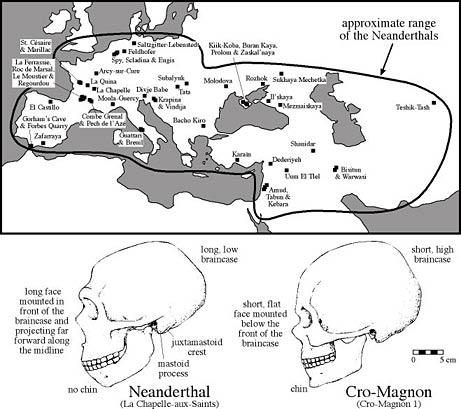Could Neandertals Have Discovered America First?
Anthropologists now believe that Neandertals may have become a seafaring people long before modern humans took to the seas for purposes of migration.Solutrean Hypothesis Smithsonian Institute anthropologist Dennis Stanford thinks that the first North Americans may well have paddled along the northern Atlantic ice shelves from Europe, over 20,000 years ago. Stanford believes that the first Europeans to go to North America were anatomically modern humans, rather than neandertals (see below). But there may be reasons to believe that Neandertals -- who likely became seafarers tens of thousands of years before modern humans -- were driven westward by population pressure from migrating sapiens.
National Geographic Some anthropologists believe the Neandertal were driven into the mountains by population pressures. And some believe they were driven into the far north, into whatever ice-free redoubts to be found. But if Neandertals were truly sea-capable travelers, what about the third possibility?
National Geographic
New evidence from the study of the Neandertal genome suggests that all modern people except sub-Saharan Africans, have portions of their genetic complement in common with the ancient Neandertal. In other words, modern humans and neandertals probably interbred at some point before the Neandertal faded away.
The time in history when neandertals slowly disappeard and modern humans became the sole representative of homo, is quite fuzzy and poorly defined. When actual bone fossils can be found, distinguishing between neandertal finds and sapiens finds is relatively easy. But most other evidence of settlement and migration is lost to history.
Stone tools can help to distinguish between different tool-making cultures, but even stone chips and blades do not necessarily provide foolproof distinctions between groups, if they are undergoing critical transitions.
One thing is for certain, scholarship on the origins of the first North American human cultures is in a state of turmoil:
Neandertal Sites
Hominid Family History
The Neandertal Genome
Sexy Archaeology Neandertals
How the Neandertal Became the Basque
Neanderthals were seafaring long before modern humans, in the Mediterranean at least. He thinks early hominins made much more use of the sea than anyone suspects, and may have used the seas as a highway, rather than seeing them as a barrier. But the details remain lost in history. Any craft were presumably made from wood, so rotted away long ago. The oldest known Mediterranean boat, a dugout canoe from Lake Bracciano in Italy, is just 7000 years old. Ferentinos speculates that Neanderthals may have made something similar.
_NewScientist
New evidence from the study of the Neandertal genome suggests that all modern people except sub-Saharan Africans, have portions of their genetic complement in common with the ancient Neandertal. In other words, modern humans and neandertals probably interbred at some point before the Neandertal faded away.
The time in history when neandertals slowly disappeard and modern humans became the sole representative of homo, is quite fuzzy and poorly defined. When actual bone fossils can be found, distinguishing between neandertal finds and sapiens finds is relatively easy. But most other evidence of settlement and migration is lost to history.
Stone tools can help to distinguish between different tool-making cultures, but even stone chips and blades do not necessarily provide foolproof distinctions between groups, if they are undergoing critical transitions.
One thing is for certain, scholarship on the origins of the first North American human cultures is in a state of turmoil:
Since the 1930s, archaeologists have favored a single migration from Siberia to Alaska as the epic event that peopled the Americas about 13,000 years ago. Stone tools found at Clovis, N.M., and elsewhere, suggested that a single culture spread across much of the continent. This “Clovis first” idea became entrenched.Unless someone invents a time machine allowing us to observe pre-historical migrations first-hand, we may never know.
But starting in the 1990s, archaeologists dated sites in Texas, Chile and the mid-Atlantic region to pre-Clovis times. Few archaeologists accepted those dates at first, said Michael Collins, an archaeologist at Texas State.
“People learned it in college and built careers on ‘Clovis first,’ ” Collins said. “They’re unwilling to turn it loose.”
But now they might have to adopt Stanford’s Europe-first slogan: “Iberia, not Siberia.” _WaPo
Neandertal Sites
Hominid Family History
The Neandertal Genome
Sexy Archaeology Neandertals
How the Neandertal Became the Basque
Labels: anthropology




0 Comments:
Post a Comment
<< Home